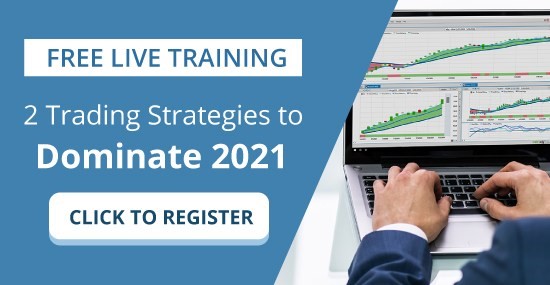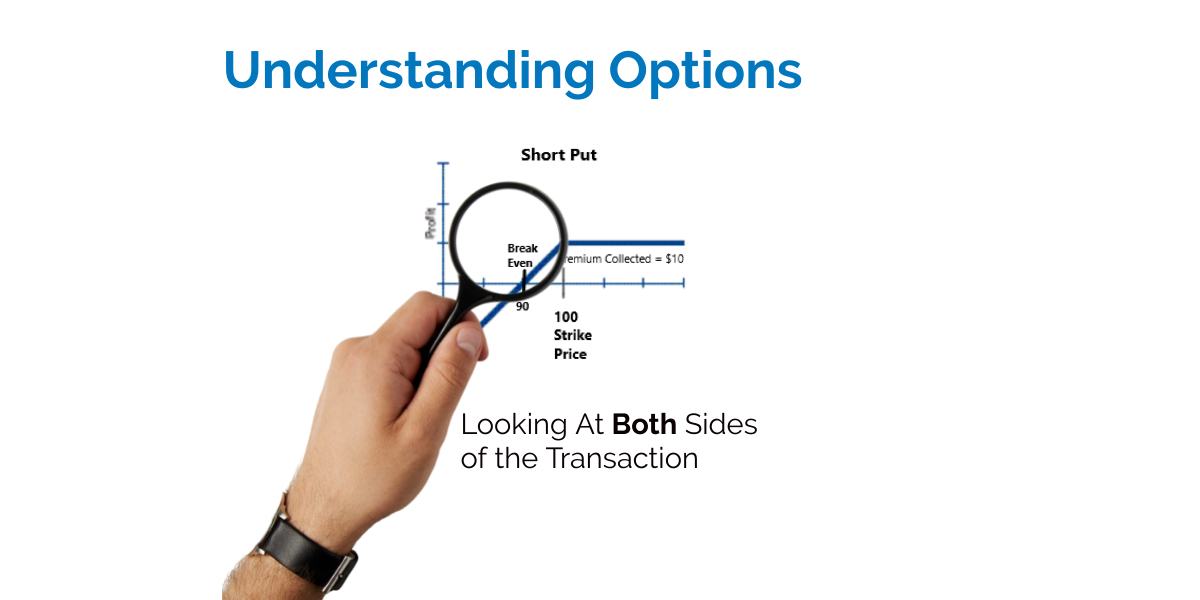
The word “Option” means choice. The more choices you have and understand, the easier it is to manage risk.
When you start learning about Options it can be very exciting. Within the buying of an Option, you have all the elements which traders gravitate towards.
- Limited risk
- Unlimited profit potential
- Leverage
Those elements are intoxicating for speculators. But where the real education regarding risk occurs is when you begin to understand the opportunities in selling Options and collecting premiums into your account. I refer to this as understanding the nuances and differences between gamblers and the casino.
For example, let’s play a game.
We are going to flip a coin. For every time you call it correctly, I will pay you 95 cents. For every time you call it incorrectly you will pay me $1. Since I’m the ‘house’ and created this game, you might’ve noticed that I have a 5-cent edge. Since a coin flip is an even money activity with 50/50 probabilities this game stacks an expected value of me consistently winning over time. So, for every 100 flips of the coin the expectation is that $100 will be wagered. You will win 50% and lose 50% of the time in your calling the coin toss accurately, but because of the wager and payout scenario I created I will make on average 2 ½ cents per flip.
This is expectation is carved into the mathematics of our transaction. It’s basic probabilities.
This is how casinos operate.
It’s also the same probability theory which guides all insurance companies in managing their affairs with their customers.
Since I have the mathematical edge, my incentive is to get you to flip as many times as humanly possible.
Based upon the game which I created above, would you rather be the gambler or the casino? If you appreciate this question and its intensity related to managing risk, you will study Options trading from all angles. There are times when you are trading that you want to be the speculator with limited risk. There are times when you are trading that you want to have the edge of the casino with a predictive risk and payout. But most importantly for those genuinely interested in trading and risk management there are huge opportunities in trading to learn how to be both simultaneously. This is where true power and choice avail themselves in the trading arena.
The evolution of Options trading starts with being a speculator and taking limited risk. As a matter of fact, any time that you buy an Option you have limited risk and the most that you can lose is the premium that you pay. The creators or seller of that Option on the other hand is creating a contractual obligation for themselves. By taking the other side of your transaction, they are collecting the premium you pay and agreeing to the terms of the contract you entered into.
Let me elaborate on this point.
Let’s say you are bullish on ABC stock.
You are convinced that it will double in the next three months. However, you don’t want to take a great deal of risk. You discover that with a call Option you can pay a premium to buy ABC between now and an expiration date and have the right to purchase the stock at an agreed upon price. As the buyer of the Option, you have limited risk. This sounds way too good to be true.
On the other end of the transaction is a trader who is looking to derive income from their portfolio. They own ABC stock at much lower prices. They learn that when they sell a call Option, they are obligating themselves to make delivery of ABC at an agreed upon price between now and an expiration date. In exchange they receive the “premium” now into their trading account.
Evaluate these two scenarios and you can begin to understand how market participants, with varying degrees of experience and different opinions will come together to create a transaction based upon their preferred risk and reward profiles.
Let’s look at both participants transactions graphically to genuinely understand the risk/reward profiles they have created.
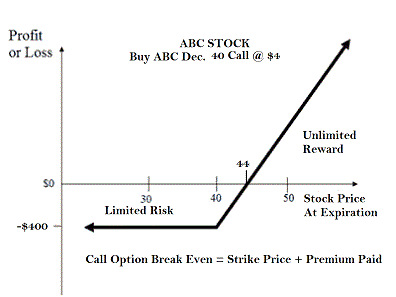
Compared to buying the underlying shares of ABC outright, the call Option buyer can gain leverage since the call Options appreciate in value faster percentagewise for every point rise in the price of the underlying stock.
However, call Options have a limited lifespan. If the underlying stock price does not move above the strike price before the Option expiration date, the call Option expires worthless.
Since there is no limit as to how high the stock price can be at expiration date, there is no limit to the maximum profit possible when implementing the long call Option strategy. And the words “unlimited profit potential” are the siren song that draws speculators into this strategy.
The formula for calculating profit is given below:
- Maximum Profit = Unlimited
- Break Even Occurs at Strike Price + Premium Paid
- At any price below the strike price the call Option will expire worthless.
- The most a call Option trader can lose is the premium paid.
There are four potential scenarios that can occur with ABC stock
- It trades sideways between now and the expiration date.
- It moves lower.
- It moves marginally higher but not over the strike price + premium paid.
- It doubles in price are you were expecting.
Unfortunately for the call Option buyer there is only one scenario in the above which will prove profitable. The stock at expiration must be trading above the strike price + premium paid for the call Option buyer to be profitable. Any other outcome will generate a loss. When call Option buyers discover that they often will think twice about this tactic.
In the above scenario let’s say ABC stock trades sideways for the next three months. You as the call Options buyer only lost the premium you paid for the right to purchase ABC. The trader who created that Option, on the other hand derived income on their portfolio from the speculation which you took.
Let’s look at the call Option seller risk reward profile. Since they own the underlying stock, this is referred to as a Covered Call.
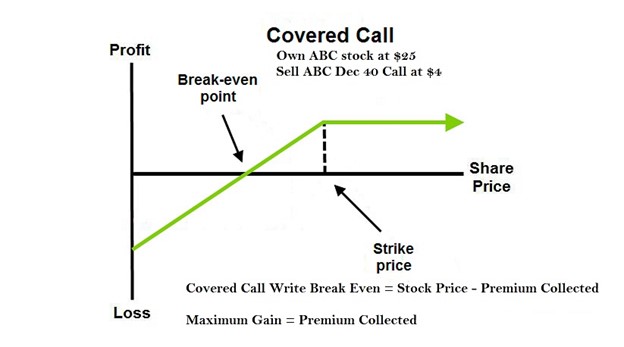
This trader owns ABC stock at $25. Let’s say it is currently at $35. When they sell the Call Option, they are obligating themselves to make delivery of ABC at $40 per share at the December Expiration. This will occur is the stock is trading above $40 at the expiration date. In exchange they received $4 into their account now.
A couple of important things occurred. Since this trader owns the stock and collected $4 in premium the stock can sell off $4 before they experience a loss. That can be quite attractive and profound for traders to experience.
The second deeply profound thing to occur is that if the stock at expiration is trading at $40 the Option will expire worthless and the covered call writer generates the gain of the stock plus the additional gain of $4 when the Option expires. This concept is very profound as by writing the Option additional profit was generated.
The Covered Call Writer maximizes their profit potential at the STRIKE PRICE. At price above $40 per share the stock will be exercised away from the call Option writer.
These two scenarios are offered simply so that you can begin to think with the myriad of possibilities that Option trading offers. The best and fastest way to acquire a powerful education in Options trading is to always ask yourself the question, “What if I’m right? And what if I’m wrong?” As you break down these scenarios for yourself you will always have to look at the other side of the Options transaction.
Where you want to get to with your own Options trading is to understand that with Options you can be completely wrong is your perspective and still make money. And you can be completely wrong in your perspective and not lose money. These realities are always juxtaposed to the initial understanding that Options traders gravitate to regarding “unlimited profit potential.”
What permitted me to grow in my Options trading is when every call Option that I purchased for a period of 6 months expired worthless. It was very painful. I was comforted by the fact that I had limited risk and unlimited profit potential. It was only then that I began to understand that I was pursuing Options trading for the unlimited profit potential aspect and not understanding or appreciating the risk management that Options afford.
When I realized that somebody was making all the money I was losing (by purchasing call Options), I dug into the nooks and crannies of Options so that I could create a better risk advantaged position for myself. That experience has made all the difference.
I strongly urge that you look at the other side of the Options transaction as it will also create the light bulb moment for your trading as well. The goal is that when you learn to combine Option tactics you can customize risk reward scenarios that are every bit as attractive as the coin toss example that I discussed earlier in this article.
Recently, I was listening to a podcast where MicroStrategy CEO Michael Saylor was discussing how he traded Apple stock shortly after publishing his book “The Mobile Wave” in 2012. Saylor was convinced that Apple was going to consume the digital world. He recognized that Apple was a trophy asset. He had gone so far as to meet with Steve Jobs while he was researching the book.

Saylor is a billionaire and leading advocate for owning bitcoin. But on this podcast, he said something that every Option trader can learn powerful lessons from.
He was wildly bullish on Apple stock. He considered Apple to be a trophy asset.
So much so that he decided to invest one million dollars into buying deep out of the money call Options on Apple stock going out one year. He felt that Apples prospects were very bright and that by the time the Options expired the Options would be in the money and he would have very sizeable profits.
Fast forward one year – and Apple stock had not reached his strike price and all his Options expired worthless.
Too bad. So sad. He lost one million dollars on this speculation.
What one action could Michael Saylor have done to completely change his results?
Instead of just buying call Options with unlimited upside potential, Saylor could have simultaneously sold at the money put Options and used the premium he collected from selling the puts to buy the same deep out of the money call Options. We discussed that strategy in this article here.
Graphically this is what selling a put Option would look like:
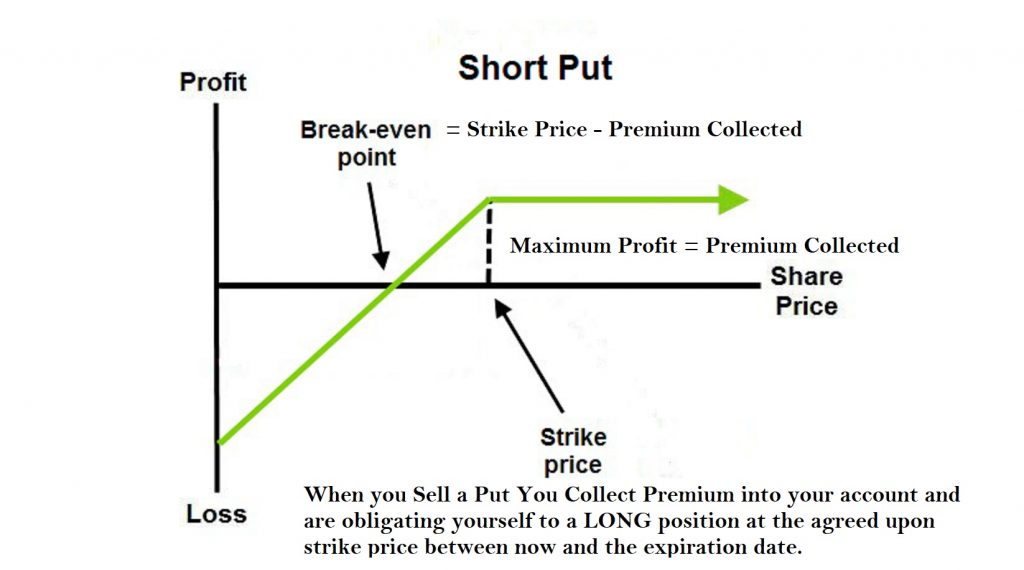
This simple tweak, simply collecting premium would finance the same identical purchasing of the calls transaction and obligated him to a long position of Apple stock in case it went lower. The outcome would have been that all the Options would have expired worthless BUT instead of losing one million dollars he would have broken even on the trade.
Theoretically, he would have collected one million dollars by selling put Options and PAID one million by buying the deep out of the money call Options.
As I said earlier, what will get you perpetually excited about Options trading is when you discover you can be wrong and not lose money.
This would have allowed him to rollover the same position to an even more distant expiration date without having lost any money. The profits could have been massive. Instead of thinking about unlimited profit potential the results can be drastically improved my simply taking risk management into account.
Saylor mentioned that he was convinced that Apple stock was going to go nuclear. Yet his timing was off. But had he financed his call purchase by selling puts his strategy would have eventually worked big time as Apple stock has gone up 977% in the last decade.
It’s important for traders to discuss their most painful trading experiences and dig into what can be learned from them. Sometimes a simple tweak is all that is needed to go from haphazard to incredible results.
I hope you never look at Options the same way again and begin to explore the other sides and possibilities of the Options transaction. Unlimited Profit Potential is very seductive. The hope is you find risk management to be equally enticing.
The sign of a great trader is not how much they make when they are right, but rather how little they lose when they are wrong.
Artificial intelligence is so powerful because it learns what doesn’t work, remembers it, and then focuses on other paths to find a solution. This is the Feedback Loop that is responsible for building the fortunes of every successful trader I know.
If you think about this question, you will begin to appreciate that A.I. applies mistake prevention to discover what is true and workable. Artificial Intelligence applies mistake prevention as a continual process 24 hours a day, 365 days a year towards whatever problem it is looking to solve.
That should get you excited because it is a game-changer.
It sounds very elementary and obvious. But overlooking the obvious things often hurts a traders’ portfolio.
The basics are regularly overlooked by inexperienced traders.
The beauty of neural networks, artificial intelligence, and machine learning is that it is fundamentally focused on pattern recognition to determine the best move forward. When these technologies flash a change in forecast it is newsworthy. We often do not understand why something is occurring but that does not mean that we cannot take advantage of it.
A.I., through advanced pattern recognition, analyzing hundreds of thousands of data points, and crunching millions of computations, finds the highest probability trades and is indispensable in separating fact from fiction.
Artificial intelligence has decimated humans at Poker, Jeopardy, Go! and Chess. Why should trading be any different?
Intrigued? Visit with us and check out the A.I. at our Next Live Training.
Discover why artificial intelligence is the solution professional traders go-to for less risk, more rewards, and guaranteed peace of mind.
It’s not magic. It’s machine learning.
IMPORTANT NOTICE!
THERE IS SUBSTANTIAL RISK OF LOSS ASSOCIATED WITH TRADING. ONLY RISK CAPITAL SHOULD BE USED TO TRADE. TRADING STOCKS, FUTURES, OPTIONS, FOREX, AND ETFs IS NOT SUITABLE FOR EVERYONE.
DISCLAIMER: STOCKS, FUTURES, OPTIONS, ETFs AND CURRENCY TRADING ALL HAVE LARGE POTENTIAL REWARDS, BUT THEY ALSO HAVE LARGE POTENTIAL RISK. YOU MUST BE AWARE OF THE RISKS AND BE WILLING TO ACCEPT THEM IN ORDER TO INVEST IN THESE MARKETS. DON’T TRADE WITH MONEY YOU CAN’T AFFORD TO LOSE. THIS ARTICLE AND WEBSITE IS NEITHER A SOLICITATION NOR AN OFFER TO BUY/SELL FUTURES, OPTIONS, STOCKS, OR CURRENCIES. NO REPRESENTATION IS BEING MADE THAT ANY ACCOUNT WILL OR IS LIKELY TO ACHIEVE PROFITS OR LOSSES SIMILAR TO THOSE DISCUSSED ON THIS ARTICLE OR WEBSITE. THE PAST PERFORMANCE OF ANY TRADING SYSTEM OR METHODOLOGY IS NOT NECESSARILY INDICATIVE OF FUTURE RESULTS. CFTC RULE 4.41 – HYPOTHETICAL OR SIMULATED PERFORMANCE RESULTS HAVE CERTAIN LIMITATIONS. UNLIKE AN ACTUAL PERFORMANCE RECORD, SIMULATED RESULTS DO NOT REPRESENT ACTUAL TRADING. ALSO, SINCE THE TRADES HAVE NOT BEEN EXECUTED, THE RESULTS MAY HAVE UNDER-OR-OVER COMPENSATED FOR THE IMPACT, IF ANY, OF CERTAIN MARKET FACTORS, SUCH AS LACK OF LIQUIDITY. SIMULATED TRADING PROGRAMS IN GENERAL ARE ALSO SUBJECT TO THE FACT THAT THEY ARE DESIGNED WITH THE BENEFIT OF HINDSIGHT. NO REPRESENTATION IS BEING MADE THAT ANY ACCOUNT WILL OR IS LIKELY TO ACHIEVE PROFIT OR LOSSES SIMILAR TO THOSE SHOWN.


